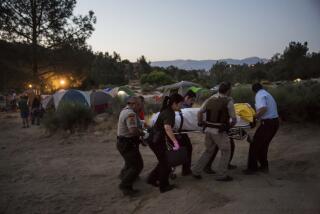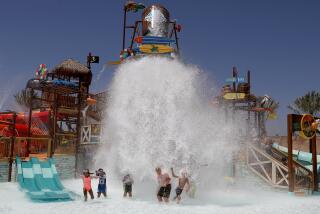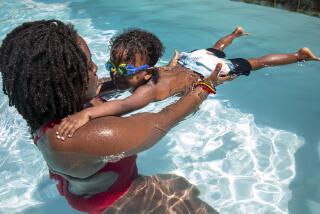Child Drownings Often Happen Even When Adults Are Near
When a drowning occurs involving a young child, it is usually assumed that this child was not supervised during the time of the drowning. A report released this year by the U.S. Consumer Product Safety Commission, however, reveals that most young children involved in a drowning were being supervised by one or both parents. A fact sheet prepared by the National Safe Kids Campaign--of which Vice President Al Gore and his wife, Tipper, are honorary chairs--reinforces this idea. It states that of all preschool children who drown, about 70% are in the care of one or both parents at the time of the drowning.
This information was one of the main reasons the Orange County Fire Authority and Childrenâs Hospital of Orange County developed this yearâs âWater Watcherâ program. In the past, it generally was assumed that young children who drowned were not supervised.
The idea of the Water Watcher program is to have one person responsible to watch the water when children are in and around the pool area. The person should know proper CPR procedures, know how to swim and how to dial the emergency 911 number. The person wears a Water Watcher badge around his or her neck. This designated individual never leaves the pool area while children are swimming and makes sure all the proper preventive steps are followed to secure the pool area when the swimming is over and everyone has left the pool area.
Many drownings, however, occur when children are not supposed to be near the pool area. The U.S. Consumer Product Safety Commission report stated that 46% of last yearâs drowning victims nationwide were last seen in the house; 23% in the yard or on porch or patio; and 31% were in or around the pool before the accident. Adding the first two categories, we see that 69% were not supposed to be near the pool area.
The Orange County Fire Authority, which provides fire protection and emergency medical services to 19 cities and all the unincorporated areas in Orange County, has responded to 30 drownings and near-drownings since March. The majority involved children younger than 5. These statistics are a sobering reminder that this problem is reaching epidemic proportions and needs to be addressed by an aggressive community education campaign.
There are three basic reasons why child drownings occur when children are being supervised. The first reason is the time factor. It takes only a few seconds for a child to drown. Drownings can happen while someone is answering the telephone or doorbell, checking on food being cooked in the kitchen or watching something on television. The Consumer Product Safety Commission reveals that 77% of last yearâs drowning victims had been missing for five minutes or less.
The second factor is noise. Child drowning is a silent death. Because young children do not fear the water or know what is happening to them, there is no splashing or yelling to alert anyone that the child is in trouble.
Third is the factor of being lulled into a false sense of security. Fences and gates are useless unless they are set and are working properly.
In addition to the Water Watcher program, the Fire Authority and Childrenâs Hospital have prepared a list of âaction stepsâ to prevent child drownings:
1) Protection: Use layers of barrier protection between the child and water to warn and impede. Pool and spa owners can take practical steps to make their pool and spa less dangerous by installing layers of protection. These include:
* A 5-foot fence that cannot be climbed, completely separating poor or spa from residence.
* Alarms on doors and windows leading to the water, installed 5 feet above ground level.
* Self-closing and self-latching fence gates. Side gates and doors leading to the pool/spa area, with latches above a childâs reach (54 inches high). Gates should open outward.
2) Supervision: Water, with its rippling, shimmering appeal, is a magnet for toddlers. Children younger than 5 have no fear of water and no concept of death. They associate water with play, not danger. Adults must establish and communicate responsibility for child supervision.
* Assign an adult âwater watcherâ to supervise the pool/spa area, especially during social gatherings.
* Assign a second adult to maintain constant visual contact with children in the pool/spa area. Donât assume someone else is watching a child.
* Never leave a child alone near a pool/spa, bathtub, toilet, water-filled bucket, pond or any standing water in which a childâs nose and mouth may be submersed.
* Donât allow children to play in the pool/spa area.
* Look in the pool area first if a child is missing.
3) Preparation: Insist that anyone older than 14 have current CPR training in infant/child safety.
* Communicate pool safety measures with the baby-sitter and train the sitter on infant/child CPR.
* Learn how to swim and learn rescue techniques.
* Mount rescue equipment by the pool such as lifesaving ring, shepherdâs hook and CPR sign.
* Post 911 emergency number on all phones. Have phone near pool area.
For more information about childhood drowning prevention, call the Orange County Fire Authority, community relations and education section at (714) 744-0496 or Childrenâs Hospital of Orange County at (714) 532-8887.
More to Read
Sign up for Essential California
The most important California stories and recommendations in your inbox every morning.
You may occasionally receive promotional content from the Los Angeles Times.










